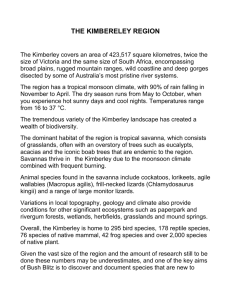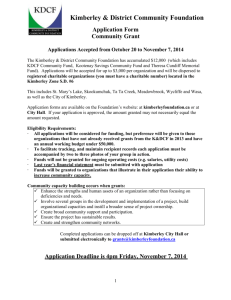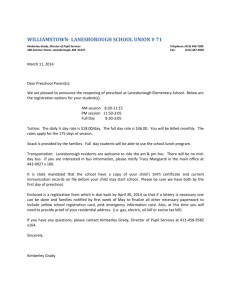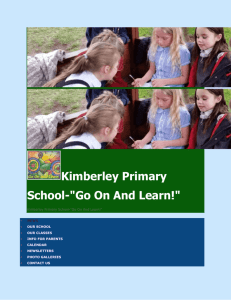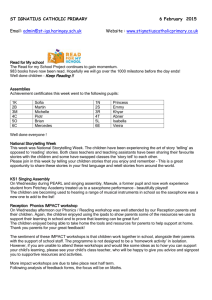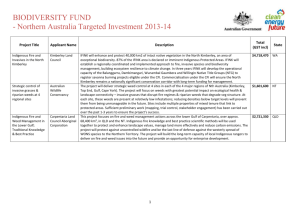Porter et al
advertisement
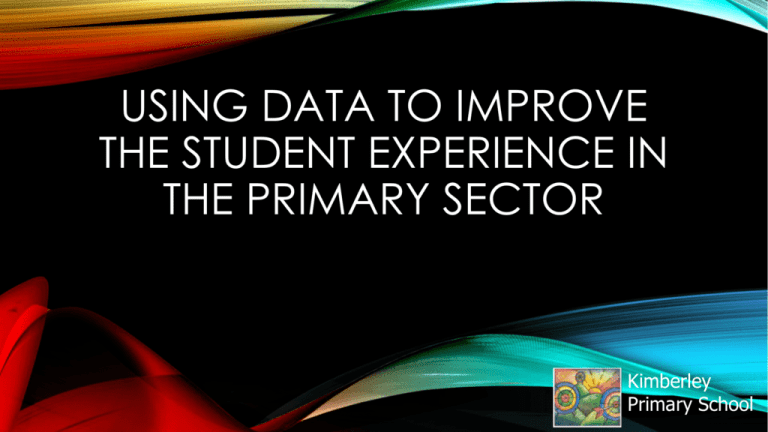
USING DATA TO IMPROVE THE STUDENT EXPERIENCE IN THE PRIMARY SECTOR Kimberley Primary School EXPECTED OUTCOMES •To understand one example model of using data to enhance the pupils learning journey in the primary sector. Kimberley Primary School “At Kimberley Primary School, we challenge every individual to Go On And Learn. We value and respect everyone’s contributions. Working together, we will be the best that we can be.” G.O.A.L Jennifer Porter Headteacher Kimberley Primary School OUR SCHOOL • 163 children currently on roll (including 52 place nursery). • 6 FT teachers, 6 TA, 6 classrooms.. • Mixed age classes (up to 3 years groups in one class) • Early Years Foundation Stage Unit 35 years of age • Phase 1-3 unit 5-8 years of age • Phase 4-6 unit 8-11 years of age Kimberley Primary School GO ON AND LEARN! Ability is what you are capable of doing Motivation determines what you do Attitude determines how well you do it BE THE BEST THAT YOU CAN BE! Kimberley Primary School Question 1: What is a University? Reception: A university is where monsters scare people. Where people go and scare people. ` All the scary people hide under beds and scare them. If you say ‘BOO!’, it scares them. Year 1 & 2: I think it’s really big. A place where you can learn new things. It’s for learning and it’s brown and big. It’s a school for big kids and you can play. Year 2 & 3: A place where you train for jobs. You do tests and stuff. When you’re older you go there. Where you learn what you want to be. Where you do stuff and get tested. Year 3, 4, 5 & 6: A place where you go to get a better job. A hard place to learn at. You learn a lot more, you get to train in what to do. Something you do after collage to get a job. A bit like collage and you can go for as long as you like. Question 2: What is it like at university? Reception: Some people might be red, pink , green, blue and grey. Tonnes of people are multi-coloured. You get to watch a film in the cinema and play. Lots of people learning. Year 1 & 2: It’s very big and hot. It’s boring. Where you can get a car and a job. It has a lot of classrooms. Year 2 & 3: Ginormous, crowded and busy. Full of clever people. Very big with lots of rooms. Adults and teenagers all around you. Year 3, 4 & 5: A university has strict teachers It is boring. Lots of studying going on. It is very crowded. Year 5 & 6: It can be fun, but also hardworking. A big version of a school and also harder. An educational environment. It gives you better grades. Question 3: What can you do at university? Reception: You go to school. Sometimes you go to the cinema. When you go to the book fair, if you are loud, the librarian shouts at you. You can play number time. You can read. You can go on holiday and swim. Year 1 & 2: You live in there You can get your own job. Get your own car. You do very boring things. You can do maths, play and learn new stuff. Year 2 & 3: You can do science. You can learn more things. You can do history, writing and maths. You can also do S.P.A.G ( spelling, punctuation and grammar), times tables and Year 3,4,5 & 6: Learn how to achieve and train for any job. Qualify for jobs and study. You can do tests which are boring. You could do a dentist course. You could get higher grades. You can study different categories of jobs. multiplication. Question 4: What is a university for? Reception: For people who have birthday songs. To learn stuff and play. To go home to read and write. It is for garden celebration parties. To eat birthday cake. It is to find new friends. Year 1 & 2: To get a new job. To get a new school. A university is for practising new stuff. A university is to learn new things. Year 2 & 3: For learning more stuff and you can be a vet. You can learn about what you want to be. You can learn how to do stuff. You can learn new things and watch films. At the end of the year, you have a disco. Year 3,4,5 & 6: Adults who want to learn. To help young adults prepare themselves for a new job. To get higher grades. Options for better jobs. Parents Board Of Governors Local Authority DFE Ofsted HMI Receive Collect Generate Report Summarise performance The assessment and data cycle to enhance the student experience Standardise and Moderate Analyse Planning ahead for Funding Deployment of resources CPD Apply Factors Kimberley Primary School Receive, Collect and Generate data Transition Data Parents Meetings Test outcomes Marking and feedback Conversation with pupils STANDARDISE AND MODERATE Secure Judgement Phase / Team Level Cross phase moderation Inter-school moderation SUMMARISE PERFORMANCE • Pupil Progress Meetings • What are the overall percentages for the levels attained at the end of the previous Key Stage? •Both 1. Who did not make the expected progress and attainment for this cohort and who will need extensive support next year? Attainment Progress Both Progress Over the Year: 1. Number and percentage of children that have made expected progress (4PP) from the start of the current year in reading, writing and maths? 1. Number and percentage of children making greater than expected progress (+4PP) from the start of the current year in reading, writing and maths? KS1 COMPARING TO NATIONAL STANDARDS Pupil Progress Kimberley Primary School IMPLEMENT CHANGES-SO WHAT? What interventions does the data tells us the child needs to make at least expected progress or/and make the age expected level? What resources do we currently have available to support the child? How does the child best learn? Do we need something additional to support the child? ANALYSE For the child For the school REPORT Governors Local and National Government Parents Parent Teacher Consultation Kimberley Primary School PLANNING AHEAD-SO WHAT? To improve the students learning experience-what does the school need to do? What training and support do staff need in order to carry improve pupils learning outcomes? QUALITY OF MARKING • Marking colour codes (for all subjects): • Class teachers and support staff mark in red • Supply teachers and student teachers mark in black • Pupils mark in green • Pupils respond in purple The receive and implement aspects of the cycle can also act as a stand alone function –formative assessment. The external work of the senior leaders will, to some extent , operate autonomously from the teaching, learning and assessment cycle-feeding information and receiving information at various times. SUMMARY • Know the child before they start with us-gathering the data from as many sources as possible • Use the information to tailor their educational flight path • Re-asses the pupils attainment and progress-formatively and summatively • Apply any factors • Summarise the performance of groups and cohorts for comparison between groups, trends over time and against the local and national picture • Change the educational flight paths for pupils as a result of what data tells us using current or additional resources available. • Monitor and review HOW DOES THE SAMPLE PRIMARY MODEL COMPARE TO THE MODELS APPLIED TO YOUR SETTING? WOULD YOU LIKE TO KNOW ANY MORE ABOUT THE BRIEF INFORMATION WE HAVE SHARED WITH YOU TODAY? THANK YOU FOR YOUR ATTENTION • Kimberley Primary School Team www.kimberleyprimary.org.uk head@kimberley-pri.notts.sch.uk
